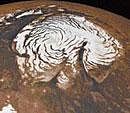"Our models tell us that if there is water present in the Martian sub-surface, then it could be habitable," said doctoral student Eriita Jones from the Planetary Science Institute of the Australian National University.
"We know that there is a hot, deep biosphere on Earth that extends to around five kilometres. If there is a hot deep biosphere on Mars, our modelling shows that it could extend to around 30 kilometres," study co-author Charley Lineweaver added.
The same scientists had modelled the earth earlier and identified water that was inhabited and water that was not, the Astrobiology Journal reported.
In this research, they applied the same technique to Mars and found that a large fraction of the Martian sub-surface could be harbouring habitable water, according to a university statement.
"We found that about three percent of the volume of present-day Mars has the potential to be habitable to terrestrial-like life. This is compared to only about one percent of the volume of the Earth being inhabited," said Lineweaver.
"Our conclusion is that the best way to find water - or potentially microbes - on Mars is to dig. Sadly, NASA's Curiosity Rover, which is scheduled to land on Mars in August, has a limited capacity to scratch the surface to 10 or 20 centimetres," he added.
